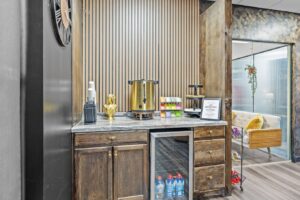You’ve just completed your residential program and you may be asking yourself: what happens after completing rehab? Your journey toward lasting recovery continues beyond detox and therapy sessions. In Charlotte, NC, Nova Recovery Center offers a structured, clinically grounded environment to guide you through each phase—from inpatient stabilization to partial hospitalization and intensive outpatient care. By understanding your next steps, you can choose the right level of support, manage relapse risks, and build a strong foundation for long-term sobriety.
Comparing levels of care
To maintain progress after rehab, you’ll move through a continuum of care that matches your needs and life obligations. Three common options are residential (inpatient) treatment, partial hospitalization programs (PHP), and intensive outpatient programs (IOP).
Residential treatment overview
Residential treatment provides round-the-clock supervision in a live-in setting. You receive daily individual therapy, group sessions, medical monitoring, and holistic support without the distractions or triggers of everyday life.
- Duration: typically 30–90 days or longer
- Intensity: 24/7 care and structured daily schedule
- Ideal for: individuals with severe addiction or co-occurring disorders
For a deeper comparison, see our guide on difference between inpatient and outpatient rehab.
Partial hospitalization programs
A partial hospitalization program offers daytime clinical care while you return home in the evenings. PHPs bridge the gap between inpatient and outpatient services.
- Duration: 4–6 weeks on average
- Schedule: 20–25 hours of therapy per week
- Focus: stabilizing symptoms, teaching coping skills, and stepping down care
Learn more in our partial hospitalization program overview and see how a php vs iop addiction treatment explained.
Intensive outpatient programs
IOPs deliver flexible, structured therapy that you can fit around work or family commitments.
- Duration: 8–12 weeks on average
- Schedule: 9–20 hours per week, often evenings or weekends
- Benefits: continued peer support, accountability, and skill-building
Explore how intensive outpatient treatment works and what to expect during outpatient rehab.
Side-by-side comparison
| Program type | Intensity | Schedule | Typical duration | Ideal for |
|---|---|---|---|---|
| Residential | Very high | Live on-site, 24/7 structure | 30–90 days | Acute cases, medical oversight needed |
| Partial hospital | High | 20–25 hrs/week, day program | 4–6 weeks | Stepping down from inpatient care |
| Intensive outpatient | Medium | 9–20 hrs/week, flexible timing | 8–12 weeks | Balancing treatment with daily life |
Planning step-down care
Once you finish a formal rehab program, it’s vital to arrange transitional support and aftercare. Step-down care ensures you don’t leave treatment without a safety net.
Transitional living and sober homes
Sober living residences provide a structured, substance-free environment where you share responsibilities with peers in recovery. You follow house rules, attend meetings, and practice new coping skills before full reintegration.
- Peer accountability and routine
- Supervised curfews and chore rotations
- Ongoing case management
Structured outpatient programs
These programs extend the therapeutic framework of PHP and IOP into your daily life. You attend regular therapy sessions, group meetings, and life-skills workshops.
- Link therapy goals with real-world challenges
- Access clinical support while living at home
- Gradual increase in personal responsibility
See our overview of a structured outpatient program for recovery.
Aftercare planning essentials
An effective aftercare plan is personalized and evolves over time. Key components include:
- Continued therapy or counseling sessions
- Medication management (where appropriate)
- Family involvement and education
- Alumni support and peer mentoring
Read about step-down care after residential treatment and how to build your long-term strategy.
Managing relapse risk
Relapse is a common part of recovery, affecting 40–60% of people post-treatment [1]. Most slips occur within the first six months [2]. By recognizing triggers and creating a relapse prevention plan, you guard your sobriety.
Recognize common triggers
- Emotional stress or mood swings
- Social situations tied to substance use
- Financial pressures and instability
- Toxic relationships or environments
Develop coping strategies
- Mindfulness meditation and relaxation exercises
- Journaling to process cravings and thoughts
- Exercise or outdoor activities to reduce stress
- Hobby exploration for positive focus
Create a relapse prevention plan
- Identify personal triggers and warning signs
- List coping techniques and healthy distractions
- Compile emergency contacts (sponsor, therapist, sober friend)
- Outline specific action steps if cravings intensify
- Review and update the plan with a counselor regularly
A formalized prevention plan can be the difference between a momentary lapse and a full relapse. For guidance on crafting one, consider tips from Bold Health.
Establishing ongoing support
Sustained recovery hinges on a robust support network and continuous care. After primary treatment, you’ll benefit from evidence-based services that bolster resilience and accountability.
Continue therapy and counseling
Ongoing individual or group therapy addresses underlying issues, co-occurring disorders, and life transitions. Regular sessions foster:
- Emotional regulation and self-awareness
- Skills to navigate stressors and triggers
- Progress monitoring and course correction
Explore evidence-based addiction treatment options and personalized treatment plans for recovery.
Engage in peer support groups
Twelve-Step programs such as AA or NA, and non-12-Step alternatives, provide community and shared experience. Benefits include:
- Sense of fellowship and belonging
- Practical advice from those in long-term recovery
- Opportunities to sponsor or mentor others
Schedule regular check-ins
Consistent follow-up with a therapist, primary care physician, or psychiatrist helps you:
- Monitor mental health and medication needs
- Address lingering withdrawal or PAWS symptoms
- Adjust your care plan as life demands shift
Consult our guide to the continuum of care in addiction recovery for more.
Evaluating program fit
Deciding which program best aligns with your situation requires honest self-assessment and research. Use these steps to pinpoint the right level of care.
Assess your needs and goals
- Severity of substance use and withdrawal history
- Co-occurring mental health conditions
- Work, school, or family obligations
- Insurance coverage and financial considerations
Compare program features
- Treatment modalities (CBT, DBT, holistic therapies)
- Staff credentials and therapist-to-client ratios
- Facilities and amenities
- Aftercare and alumni services
Refer to how to know if you need inpatient rehab and what makes a good rehab program.
Plan your next steps
- Schedule tours or virtual visits
- Verify insurance benefits and out-of-pocket costs
- Consult with your support system or case manager
- Confirm admission requirements and intake dates
For additional guidance, read how to choose the right addiction treatment program.
Next steps in Charlotte
As you transition from formal treatment to a new chapter, Nova Recovery Center in Charlotte, NC, stands ready to support your continued growth. We offer tailored programs across all levels of care, a compassionate clinical team, and a commitment to evidence-based practices.
Explore Nova’s programs
- Inpatient residential treatment for intensive stabilization
- Partial hospitalization to hone coping skills
- Intensive outpatient services that fit your schedule
Learn about the best rehab programs in charlotte nc.
Reach out for assessment
Contact our admissions team to discuss your history, clinical needs, and recovery goals. We’ll help you select the level of care that keeps you safe and empowered.
Schedule a consultation
Take the next step toward lasting sobriety. Call Nova Recovery Center or complete our online form to arrange a free, no-obligation consultation. Your recovery journey is ongoing—let us guide you through every phase.








